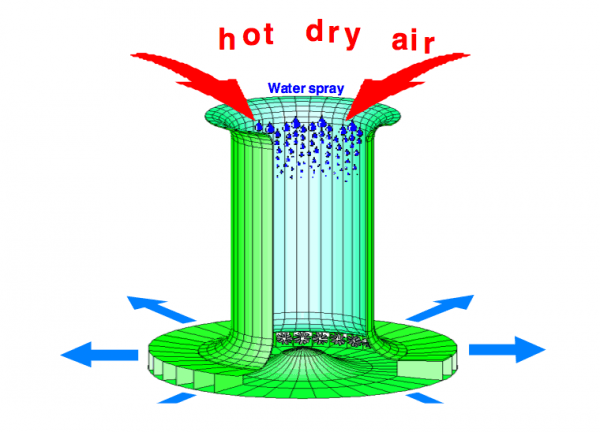Imagine a power plant that used only cold air to spin a turbine: no need for expensive solar PV panels or gigantic wind turbines.
The theory is simple, says Dan Zaslavsky, a professor of agricultural engineering at the Technion, Israel’s Intitute of Technology. The mastermind behind the Energy Tower, Zaslavsky says the technology uses a principle that’s been known for hundreds of years: “If you spray water into the air, the air cools. Cool air is heavier than hot air, and it drops down,” he told EarthTechling in a phone interview.

The abundance of hot dry air in Israel’s desert climate, makes the damp cold air drop to the bottom of the tower very effectively. There its spins a turbine that is connected to a generator, creating electricity from nothing but cool air, 24 hours a day, seven days a week. According to Vi, who designed the Energy Tower that can do just this, the technology can supply electricity at the lowest known cost (2.5-3.5 cents per kilowatt-hour), on a relatively small plot of land and in the widest range of climate conditions.
With a severe scarcity of water in Israel, Zaslavsky realized quickly he would have to find a a good way to use the water for the tower as efficiently as possible. And that led his team to a perhaps even greater discovery: The tower would also work with ocean water, and as the ocean water goes through the tower, it actually self-desalinates so that there is a freshwater byproduct.
Israel is already pouring millions of dollars into desalination plants because it is quickly depleting its freshwater resources. But the Energy Tower can produce freshwater more cheaply than a traditional desalination plant, according to Zaslavsky, all the while producing many megawatts of renewable energy.
Zaslavsky has also toyed with the idea of setting up fisheries next to the Energy Towers. Raising fish could compensate for the cost on transporting thousands of gallons of ocean water into the desert and could fill a much needed gap in supply of shore-side fishery real estate.
The idea is so revolutionary that UNESCO has asked Zaslavsky to write a full report on his research, which includes various other Israel-based renewable energy visions, with the hope that renewable energy supplies in the region can be multiplied in the coming years.
But while Zaslavsky may have been among the first to think of the idea, other companies are commercializing similar technologies. In October 2011, EarthTechling reported on a downdraft wind tower currenrly being developed by Marlyand company Clean Wind Energy. Calling it the “Downdraft Tower,” Clean Wind Energy also thought of locating it technology in the desert, but in the American Southwest. In late April, the company said it would finally be proceeding with plans to construct two of their enormous 3,000-feet tall towers in the Arizona desert as part of an innovative new wind power, although there was no indication of where the financing for the project might come from.
Zaslavsky notes that the idea is particularly novel because it is based on the idea that the sun’s power can be captured in the “fruits of the sun.” Although the sun does not shine 24 hours a day, the sun heats up the desert air, making it hot around the clock and capable of powering the Energy Tower.

But because the tower needs to be very tall to operate most effective — approximately a kilometer (0.62 miles) in height — some have cited an aesthetic concern with mass deployment of the technology. This has also been cited as a problem with Clean Wind Energy’s Arizona project. But as various countries around the world race towards 2020 renewable energy goals and wind turbines — onshore and offshore — solar panels and other renewable energy power plants begin to dot landscapes, people may learn to see the value in renewable energy and fight less to keep energy out of sight and out of mind.
Another issue cited with the tower concept: bird collisions and deaths, a perennial issue with large wind turbines that have rapidly-spinning blades cutting throught he air.
For his part, Zaslavsky has already begun the commercialization process for the Water Tower, building a company called Sharav Sluices that has already received some seed money for research and development and a green light from Israel’s Ministry of Energy. He is hoping to secure larger scale investment to being more serious deployment of the Water Towers.
The first scientist to work for Israel’s Ministry of Energy, Zaslasky formerly served as the chair of Israel’s National Council for Research & Development which was established in 1982 by the country’s Ministry of Science & Technolgoy.
Watch a video in Hebrew of Professor Zaslavsky presenting his invention.